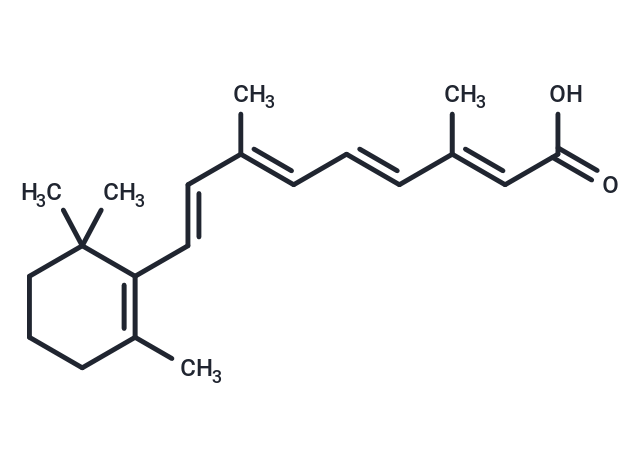Shopping Cart
- Remove All
 Your shopping cart is currently empty
Your shopping cart is currently empty

Retinoic acid (Tretinoin), a metabolite of vitamin A, is a natural agonist of the retinoic acid receptor RAR and inhibits RARα/β/γ (IC50=14 nM). Retinoic acid induces cellular differentiation, reduces cellular proliferation, and inhibits tumorigenesis.

| Pack Size | Price | Availability | Quantity |
|---|---|---|---|
| 50 mg | $33 | In Stock | |
| 100 mg | $48 | In Stock | |
| 1 mL x 10 mM (in DMSO) | $50 | In Stock |
| Description | Retinoic acid (Tretinoin), a metabolite of vitamin A, is a natural agonist of the retinoic acid receptor RAR and inhibits RARα/β/γ (IC50=14 nM). Retinoic acid induces cellular differentiation, reduces cellular proliferation, and inhibits tumorigenesis. |
| Targets&IC50 | RARα:14 nM, RARβ:14 nM, RARγ:14 nM |
| In vitro | Tretinoin prevents skin atrophy induced by corticosteroids in hairless mice. When co-administered with miquimod in guinea pigs, tretinoin induces tattoo fading and moderate pigment clearance histopathologically. Applications of tretinoin on incisions in the skin of 45 CD-1 mice increase fibroblast differentiation and reduce collagen production. In aged male Fischer 344 rats treated with tretinoin, renal cortex protein content is 30% lower compared to controls, potentially due to suppressed expression of tumor necrosis factor-β1 and osteopontin. |
| In vivo | In studies evaluating the impact on glutathione levels and catalase activity, Tretinoin increased both metrics in a time- and dose-dependent manner, offering protective and mitigating effects against H2O2 cytotoxicity in human renal mesangial cells. Treatment with Tretinoin resulted in elevated mRNA levels of catalase and γ-glutamylcysteine synthetase (the catalytic subunit responsible for the rate-limiting step in reduced glutathione synthesis) in cultured mesangial cells. Additionally, Tretinoin upregulated matrix metalloproteinase-8/13 in human keloid-derived fibroblasts. |
| Cell Research | Retinoic acid is dissolved in DMSO and stored, and then diluted with appropriate medium before use[3]. P19 cell are induced to undergo neuronal differentiation according to established procedures. Briefly, cells are cultured on 1% agarose-coated 10 cm dishes at 3×10 5 cells/mL in α-minimal essential medium supplemented with 10% FBS. Differentiation is induced by addition of Retinoic acid (1 μM) and medium containing Retinoic acid replaced 2 days later. On day 4, cell aggregates are collected by centrifugation, separated to single cells by trypsin/EDTA treatment, replated onto poly-L-lysine-coated plates, and cultured in α-minimal essential medium supplemented with 10% FBS. On day 6, medium is replaced with neurobasal medium containing B27 supplement and 2 mM GlutaMAX. Medium is replaced every 2 days for an additional week[3]. |
| Alias | Vitamin A acid, Tretinoin, ATRA, all-trans-Retinoic acid |
| Molecular Weight | 300.44 |
| Formula | C20H28O2 |
| Cas No. | 302-79-4 |
| Smiles | CC(/C=C/C1=C(C)CCCC1(C)C)=C\C=C\C(C)=C\C(O)=O |
| Relative Density. | 1.0597 g/cm3 (Estimated) |
| Storage | keep away from direct sunlight,store at low temperature | Powder: -20°C for 3 years | In solvent: -80°C for 1 year | Shipping with blue ice. |
| Solubility Information | DMSO: 45 mg/mL (149.78 mM) 10% DMSO+40% PEG300+5% Tween 80+45% Saline: 5.6 mg/mL (18.64 mM), In vivo: Suspension. Please add co-solvents sequentially, clarifying the solution as much as possible before adding the next one. Dissolve by heating and/or sonication if necessary. Working solution is recommended to be prepared and used immediately. Ethanol: 6 mg/mL (19.97 mM) H2O: < 1 mg/mL (insoluble or slightly soluble) |
Solution Preparation Table | |

Copyright © 2015-2024 TargetMol Chemicals Inc. All Rights Reserved.